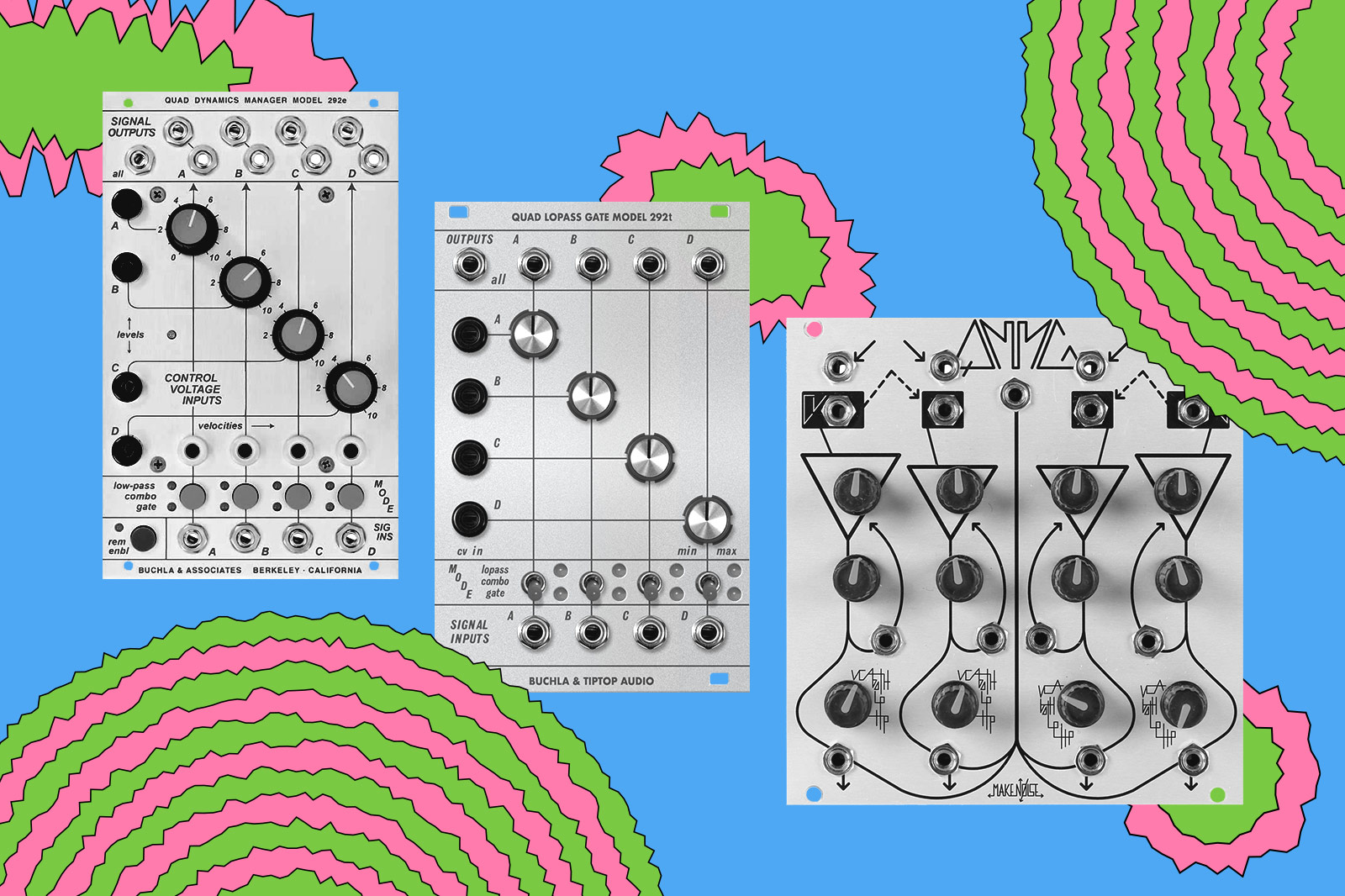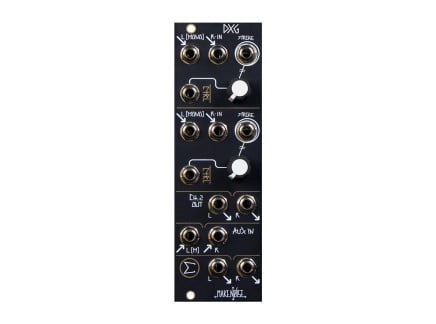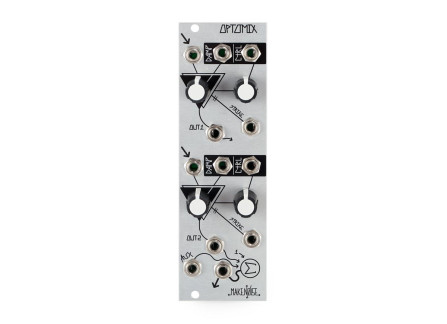Buchla bongos! Plonks! Ring! Snap! Vactrols! If you're relatively familiar with modular synthesizers, odds are that you have some sort of association between at least a couple of those words...and odds are that it somehow ties together with a very particular type of module: a Low Pass Gate.
Fifteen years ago, if you'd asked the typical synthesizer player what a Low Pass Gate was, there were reasonable odds that you'd just get a blank stare in response. Prior to that point, this type of circuit was quite uncommon, featuring prominently only in the work of outsider instrument designer/artist Don Buchla. And while Buchla's name may be well-known now, his original instruments are quite rare...and as such, before the turn of the 21st century, the Low Pass Gate wasn't exactly a cornerstone of every electronic musician's sonic toolkit. However, the advent of Eurorack modular synthesizers has changed that. Today, Low Pass Gates are a staple of modular synthesis, with many distinct takes on the idea readily available from many instrument makers.
In this article, we're going to take a closer look at the Low Pass Gate concept. Let's start with a simple definition: What is a Low Pass Gate? A Low Pass Gate is a circuit which combines filter and amplifier-like characteristics in order to simultaneously affect a sound's timbre and its loudness. Historically, it was most notably part of Don Buchla's 200 series instruments. But there's much more to explore: what makes Low Pass Gates so special? And finally, how do they fit into the total picture of musical synthesis in 2023? Keep reading to find out.
A Closer Look at Buchla's Low Pass Gate
Don Buchla's instrument designs are a deep topic with a lot of interesting twists—more than we can get into in this particular article. For some more historical context surrounding his work, I'd strongly recommend checking out our articles East Coast Synthesis vs. West Coast Synthesis and What is West Coast Synthesis...Really?, where we explore the history of and modern perspectives on his work.
That said, it's worth noting that a number of staple concepts in the modern world of modular synthesizers are owed to Don Buchla. The so-called "complex oscillator," capacitive touch plate keyboards, the looping two-stage envelope generator, and more all originated in his instruments, and can now be found throughout the landscape of Eurorack modular synths and standalone, self-contained instruments. Perhaps one of the most fascinating, idiosyncratic, and uniquely "Buchla" concepts, though, is the Low Pass Gate: a circuit that combines the behavior of a typical filter and amplifier in a very particular way.
The Low Pass Gate as we know it today first appeared in Buchla's 200 Series instruments, c. 1970 (though simpler forms had appeared in his earlier instruments). It was part of many (if not most) of the instruments that he created thereafter, including the Music Easel, Touché, and 200e system. Perhaps a good first step in getting acquainted with the concept would be to take a look at one of Buchla's best-known implementations of the Low Pass Gate: the Quad Lopass Gate Model 292c.
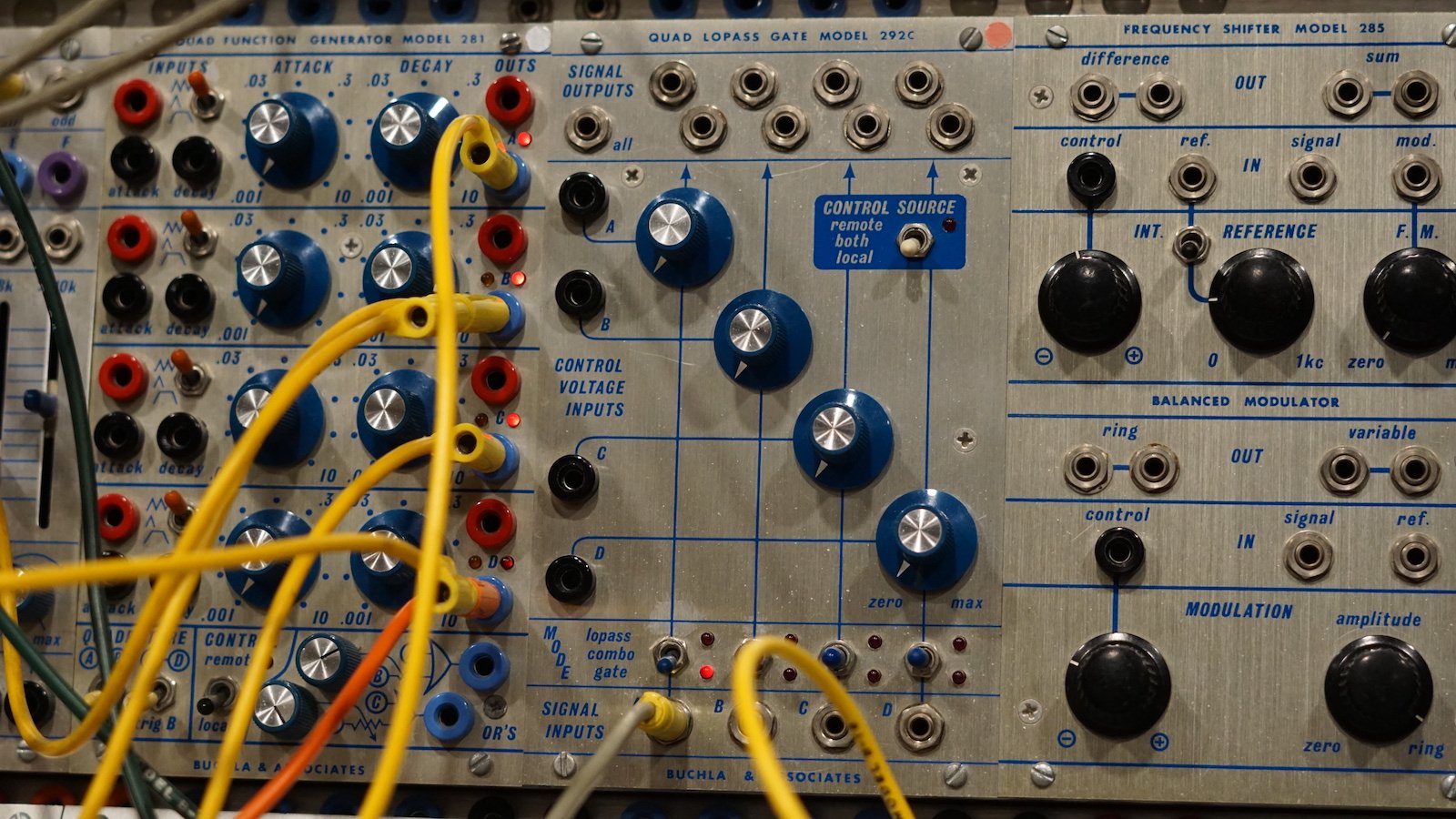
The 292c (pictured above) is a very straightforward view of a Low Pass Gate's general feature set and control layout. The 292c features four identical circuits, each with a control voltage input, a level control knob, a three-state mode selection switch, and a signal input and output. The mode selection is perhaps the most crucial point in understanding what makes this circuit so unique. If you look closely, you'll notice the three front-panel modes are called "lopass," "combo," and "gate." But what does that all mean?
In the Buchla 200 system, there isn't a module that acts exclusively like a conventional synth's voltage-controllable amplifier (VCA); nor is there a module that acts like a typical resonant lowpass filter. That's where the LPG fits into the picture: it can act like a low pass filter, a VCA, or a combination of the two. By using the "mode" switch on the 292, for instance, you can choose how the panel level control and control voltage input affects the sound. In "gate" mode, you get a more or less traditional VCA-like behavior: the level control alters the amplitude of the sound without affecting the tone color. In "lopass" mode, the given channel acts like a relatively gentle low pass filter. And in "combo" mode, it creates a coupled gentle low pass filter/amplitude control.
Of course, that begs the question: why would you want to couple the response of your filter and amplifier? In most synthesizers, much of the sonic interest is generated by very finely tuning the way that envelopes and other modulation sources affect filtering and the VCA relative to one another. That's how we create unique articulations, and where much of the sound's character is defined. Moreover, most synthesizers use resonant filters in order to add more character to the sound—and many synthesizers are prized for the sound of their filters alone. So...what was Don Buchla thinking? Why would you want to combine your filter and amplifier into a single circuit? And why is it that, as we mentioned before, this particular (seemingly limited) topology has become so popular in the era of Eurorack modular synthesizers?
Why Would You Want to Use a Low Pass Gate?
There is more to the LPG than might first meet the eye. Understanding what makes it special requires talking about some additional concepts, both sonic and technical. Let's start by talking about sound.
How does sound work in acoustic objects? A sound's brightness/sonic intensity/overtone content is dependent in part on the amount of energy that was used to set that object into motion. The harder you strike the key of a piano, the faster the hammer moves. In tandem, the louder the sound is, the brighter it is, and the longer it decays. This is true for most, if not all acoustic instruments. Think about striking a key on a marimba, or plucking a string of a guitar: the more energy you put into it, the brighter the output, and the longer the time before the sound decays to silence.
Think, too, about what happens as the sound decays. It's not the same as the sound of lowering the level on a typical synthesizer's amplifier circuit. Acoustic sound changes as it decays. It loses spectral energy as it decays, typically getting darker and quieter as it goes along.
So, a sound modifier that simultaneously affects a sound's brightness in conjunction with its loudness...actually makes a lot of sense acoustically. And in fact, that's one of the factors that contributes significantly to the "sound" of many Buchla instruments. The Low Pass Gate gives them a sound that is often described as "organic," "tactile," or acoustic-like. That's why the term "Buchla bongo" has become so commonly used: LPGs truly have an uncanny sort of acoustic "thwak" to them, and a very natural-sounding decay characteristic, not entirely unlike the sound of a bongo. It's worth noting, though, that this particular characterization of their sound—as intentionally mimicking the decay characteristics of acoustic instruments—isn't the complete picture.

Think about sound in space. If a sound source is very close to you, you can hear all of its sonic details. But what if the same sound source is much farther away? You won't hear as much of the high-frequency content: instead, you'll hear a more muted, murky, vague impression of the sound. For the most part, the lowest parts of the sound will seem most present, and will survive over the greatest distances. According to Buchla's long-time collaborator David Rosenboom (who had a hand in the development of several Buchla instruments/devices), one primary intention behind the Low Pass Gate was about creating a controllable sense of distance and movement in space. The more "open" or "excited" the gate becomes, the closer the sound will seem to be; and as the sound decays, it seems to recede into the distance. If you can get yourself into the right frame of mind when listening, this effect is actually quite striking.
How Does a Low Pass Gate Work? Vactrols, Timbre, and Time
So you might be asking yourself...couldn't you still achieve all of that with a regular old filter and amplifier? If you just control them with the same envelope (or just set their envelopes to use the same settings), don't you get all of the same results, with more control? Well, in short, the answer is "not exactly"—and that brings us to one of the most important parts of how these devices work, and what makes them feel and sound so unique.
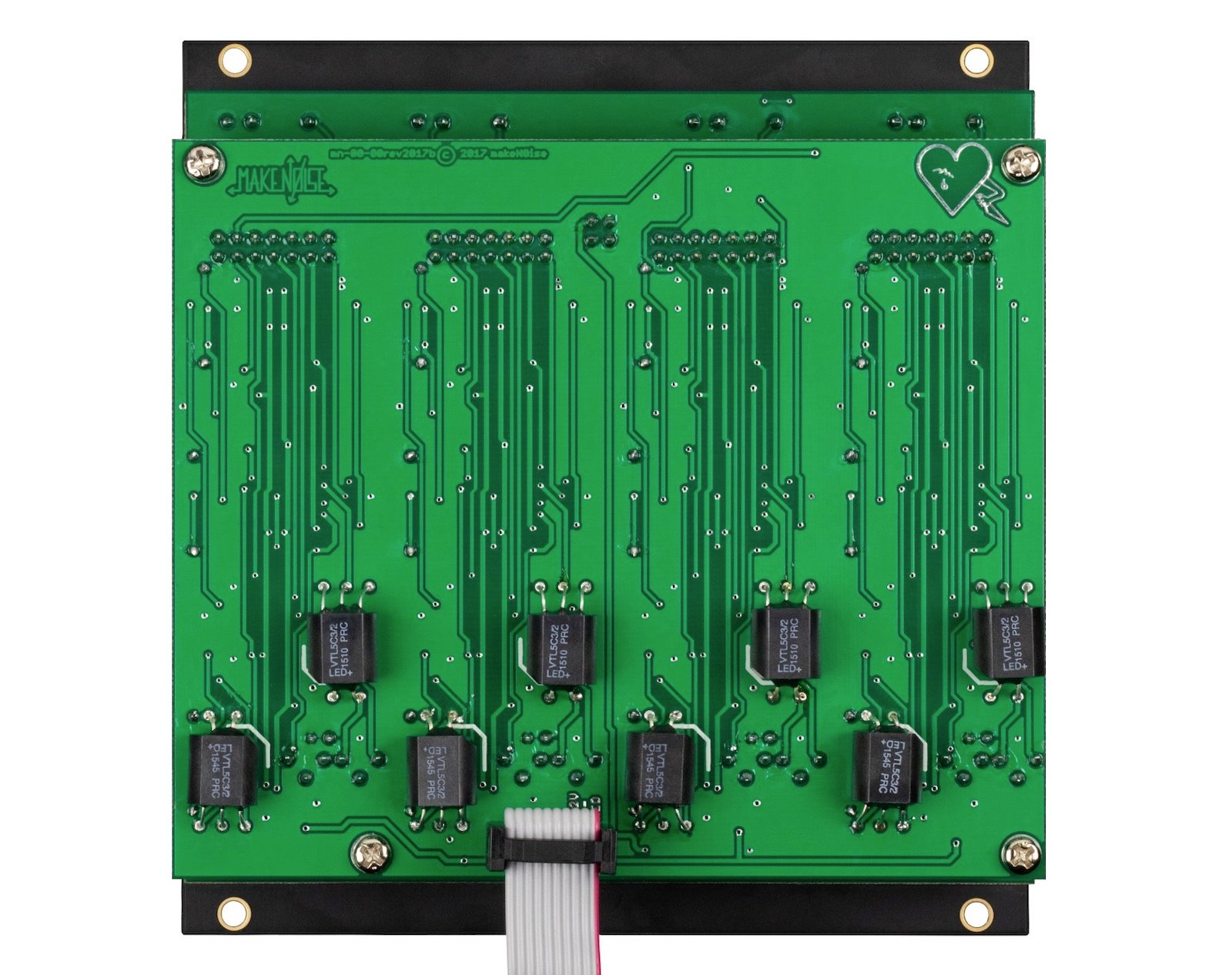
The key here is the Buchla LPG's dependence on a special/peculiar electronic component called an opto-isolator, now commonly generically referred to as a vactrol. (Note: calling an opto-isolator a "vactrol" is somewhat like calling any tissue a Kleenex; the term "vactrol" was originally a branded name for opto-isolators made by the company Vactec.) A vactrol electronically is quite simple: it's an enclosed combination of an LED and a light-dependent resistor (LDR). In short, it makes it such that you can apply a voltage to the LED and get variable resistance from the LDR (which helps to create something electronically similar to a voltage-controllable knob/potentiometer). If the electronics talk goes over your head, don't worry. The actual point is this: Buchla LPGs use a component called a vactrol for controlling their response, and because of the way they're made, vactrols...don't respond to incoming CV very quickly! (Note: the rear panel of Make Noise's 2018 QMMG can be seen above, with not one, but a whopping eight vactrols.)
In our case, that sluggish response is a good thing. In fact, it's responsible for one of the most characteristic aspects of an LPG's sound altogether: its ring. Imagine this: you're using an ADSR envelope to "open" a typical synthesizer filter & VCA. You set the attack, decay, sustain, and release values to their absolute minimum, and you press a key. What's going to happen? Most likely, all you'll hear is a tiny, barely-noticeable click. If you use the same sort of envelope with a Low Pass Gate, though, something different happens: the sluggish response will cause it to open fairly quickly, but close more slowly, creating a fairly quick, but definitely audible decay. This is a strong contributor to the LPG's "acoustic-like" or "natural" sound quality.
There are more implications than just that, though. Depending on the actual attack and decay times of the envelope, the LPG may not even open fully. The sluggishness of response means that, hypothetically, you could send it a transient envelope that was too short to "excite" it completely. That might sound lame, but it's actually an aspect of yet another unexpected benefit of the LPG. Think about it this way: the sluggish release of the LPG can be thought of as a sort of "memory." The LPG takes time to decay from its current state. But what happens if it receives another super short envelope while it's still decaying? It results in a sort of "buildup": the less time between successive "pings," generally, the more "open" the gate appears to be. This, again, is very similar to stringed or percussive instruments: if you continue to strike them as they ring out, successive strikes will build up and a result in a more continuous, energetic, bright sound.
This phenomenon means that often, you can treat an LPG quite differently from how you treat a typical filter and VCA. For instance, you don't necessarily even need an envelope to use them to create percussive sounds. Often, sending a trigger/transient to their CV inputs is enough to get a percussive "strike". Many classic Buchla patches forego use of envelopes in favor of simplyrelying on the LPG's own decay time as the source of a sound's dynamic profile. And in fact, modern LPGs like Make Noise's Optomix and LxD (pictured above) provide separate "strike" (trigger) and CV inputs so that you can always have access to both conventionally voltage-controlled and pinged/struck LPG responses. Try sending a trigger directly into a typical VCF or VCA's CV inputs...it won't be nearly as interesting.
Many LPG modules couple together two or more LPGs in a single package. Part of this is simply to give you more "bang for your buck," but there are some compelling musical reasons to do this as well. While one might first think it's just so that you can have an articulative structure for multiple voices, it can actually be a way of creating more complex articulative structures for a single voice. For instance, in the adjacent audio example, I used three lowpass gates and two envelopes on a single oscillator. One looping envelope created rapid re-articulations, while another looped more slowly. The looping envelope's pulse output was connected to the CV input of one LPG in "combo" mode; this LPG's output was connected to the input of a second LPG in "combo" mode; a slower looping envelope was used to create varying dynamic swells with the second envelope. The oscillator was sent to a third LPG, which was "pinged" by the slower envelope's end-of-cycle trigger output; the audio from that LPG and the audio from the two series LPGs were mixed together. The result is an articulation at the beginning of every string of notes, followed by a rapid stream of re-articulated notes that seem to swell in/approach from the distance and recede back into the background. This "double-gated" patch trick (using two LPGs in series) is a great way to accentuate two of the unique effects the LPG provides: the sense of "organic" articulations and the sense of "distance" described above.
What's Wrong With Vactrols?
As I alluded to above, vactrols aren't exactly high-precision components. They have remarkably wide tolerances, meaning that even vactrols from the same production batch can vary considerably in behavior. In some electronic applications, that doesn't matter so much—but in critical audio applications, it can be very important. A poorly-spec'd vactrol might cause an LPG to have an insanely long "ring time," or much too short a ring time. Moreover, in devices that require multiple vactrols, matching can be very difficult/tedious.
For other types of components, this might not be such a challenge—manufacturers just wind up buying an excess of components understanding that many won't match their specs and will just get recycled, or used in other circuits. But for vactrols, this approach isn't especially practical. Why? Well, they're very expensive. Why is that? Well...they're basically obsolete, in conventional senses—the electronics world at large has more or less found other (more effective) solutions to the problems vactrols were designed to solve. Remember, though, that the vactrol's inefficiencies are the thing that make it work so well for our musical purposes. Regrettably, musicality isn't usually among the top priorities of those designing low-level electronic components.
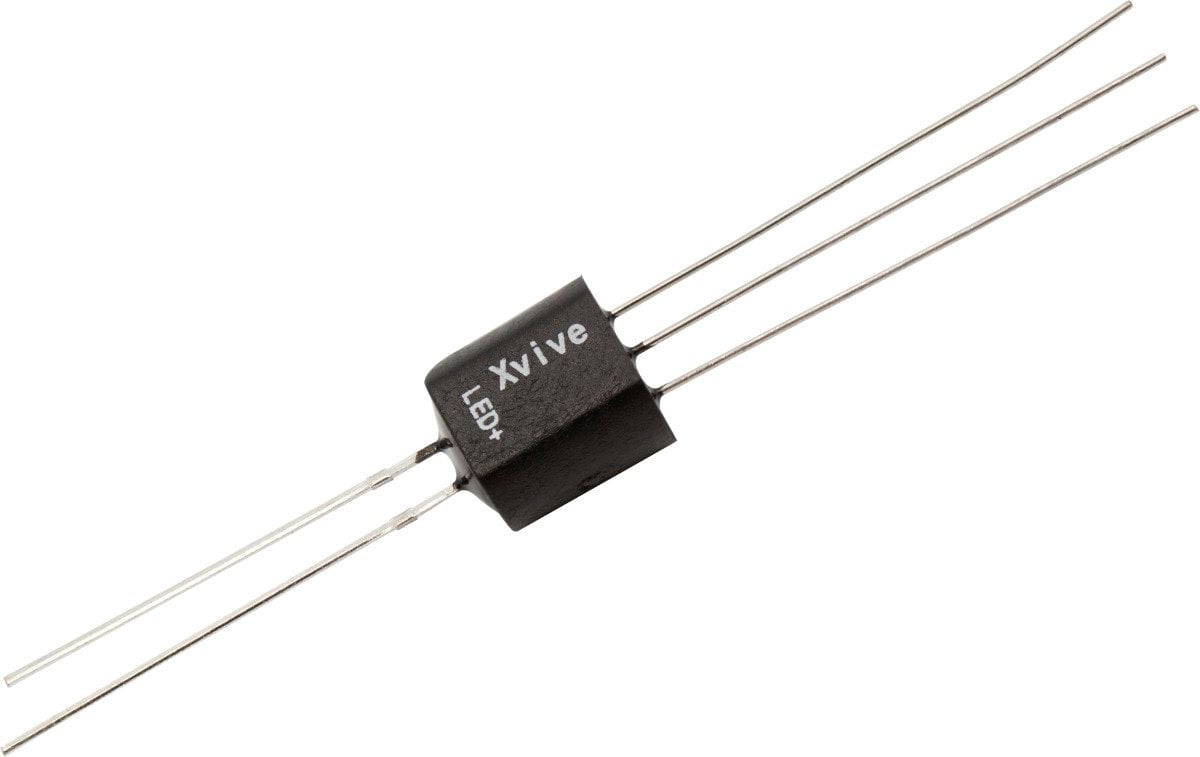
There's another complexity that makes vactrols difficult to work with, as well: the Restriction of Hazardous Substances directive (RoHS), a directive that originated in the EU to limit the use of toxic chemicals in electronics manufacturing/distribution. The photoresistors in a vactrol require cadmium in their construction. Cadmium is a known carcinogen, and is one of the materials restricted by RoHS regulations. Now, the nature of how cadmium works in a vactrol doesn't really pose a risk to your health as an end user—but, my point here is that their technical obsolescence and the RoHS restriction of cadmium means that most companies that made vactrols no longer do.
So, in many senses, vactrols aren't really a viable/practical part of new designs. But that doesn't mean people aren't still making Low Pass Gates: many are just resorting to new approaches to LPG design by modeling the quirks of vactrol response with unique, original circuitry. Yep: people are finding ways to engineer and control a vactrol's inefficiencies. Let's take a quick look at how Low Pass Gates have evolved in the last ~15 years, pointing out a few interesting examples along the way.
The Evolution of Low Pass Gates
Because of the significant influence Buchla's designs have had on modern Eurorack instrument makers, Low Pass Gates aren't exactly uncommon. And, as with many Eurorack modules based on classic instrument design concepts, most of the modern LPGs present their own unique take on how an LPG can work altogether.
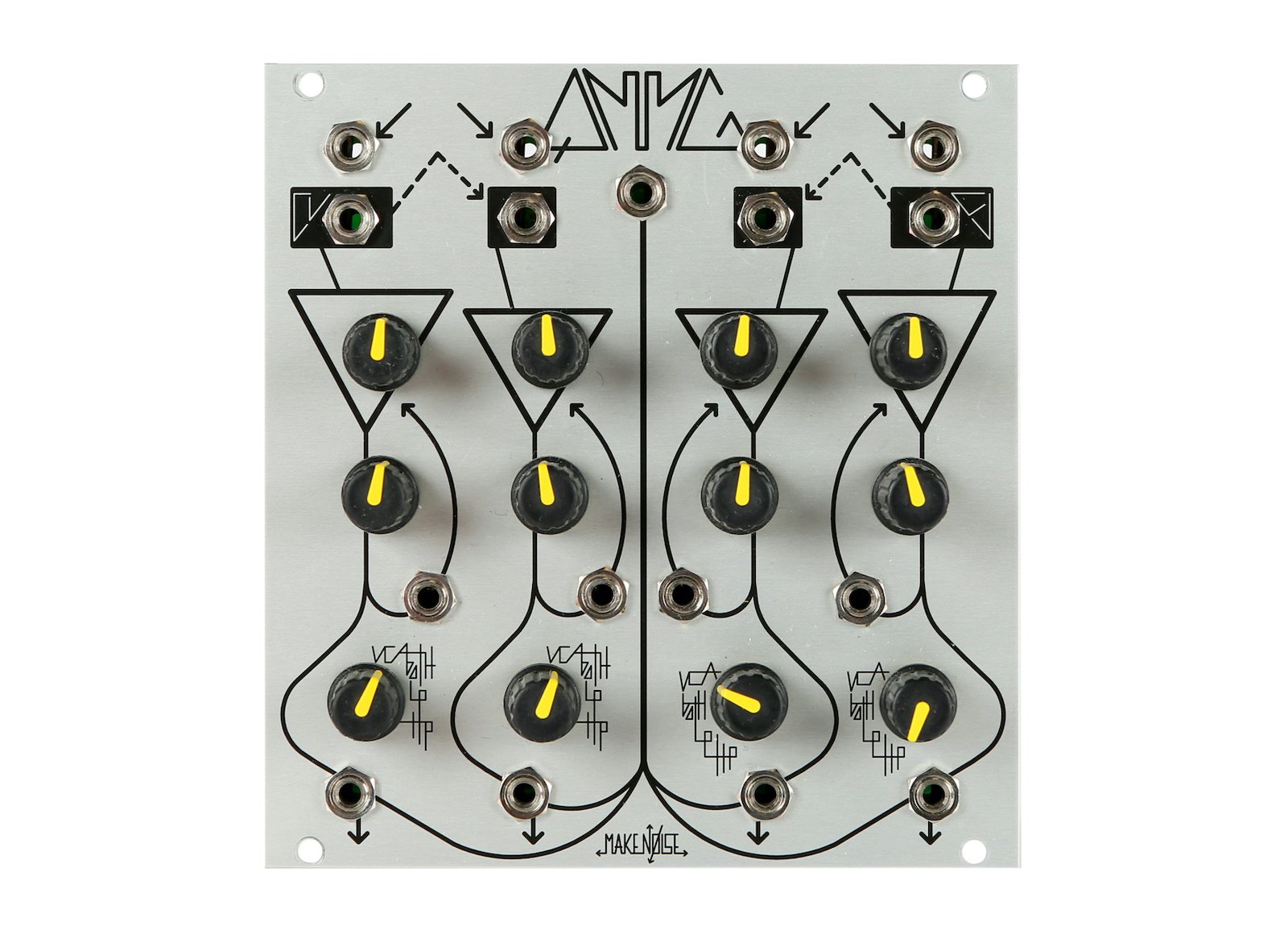
One of the earliest Euorack LPG modules was the now-iconic Make Noise Quad Multi-Mode Gate, lovingly known as the QMMG. As its name implies, the QMMG combines concepts from a multi-mode filter and a lowpass gate, providing tones otherwise impossible with a classic LPG alone. Each of QMMG's channels includes a mode selection switch for VCA, Lowpass, "Both" (like Buchla's "combo" mode), and Highpass mode. Additionally, each channel has a Feedback control knob and Feedback CV input—useful for generating a resonance-like control for the filter modes. And of course, by combining channels, you could achieve steeper filter responses, bandpass filtering, and more.
QMMG was eventually discontinued because of the expense and complexity involved in getting an adequately matched response between the vactrols used for each channel, though it was also re-released as a limited edition module in 2018 (in celebration of Make Noise's 10th anniversary). Make Noise went on to create the Optomix, a simplified two-channel LPG that added their now-characteristic "Strike" input, mentioned above. The MMG, produced beginning in 2014 but now discontinued, presented a more complex take on an individual channel of the QMMG, with continuous mode morphing under voltage control, strike and accent trigger inputs, and separate DC-coupled and AC-coupled inputs. Their LxD further simplifies the LPG design by removing all knobs and leaving only CV inputs and the Strike input for each channel.
There are, of course, plenty of other vactrol-based Eurorack LPGs—Doepfer's A-101-2, the Erica Synths Black LPG and Pico LPG, and others still maintain this design element while adding features similar to those found on the QMMG.
But, as we mentioned above, working with vactrols can be complex and inefficient, for the reasons we outlined before. As such, many companies are resorting to new techniques building LPGs. No surprise, Make Noise was one of the first companies to take on this challenge, introducing their first non-vactrol-based LPG design in 2016's 0-Coast, a self-contained instrument based on many Buchla and Moog concepts. Later, Make Noise produced the relatively short-lived Dynamix, which provided two 0-Coast-esque Dynamics circuits with signal mixing and extended control options in a single Eurorack module. But Make Noise aren't the only ones taking new approaches to LPG design.
Recently, Make Noise also introduced a new module: the DXG Dual Stereo Gate. This module takes a new approach, and in some ways represents the convergence of a couple of separate threads in the history of Make Noise's designs.
DXG uses an all-new, all-analog circuit which—like 0-Coast and Dynamix—doesn't rely on the use of vactrols. Unlike 0-Coast and Dynamix, though, DXG isn't necessarily optimized for use with high-frequency control signals. Instead, it was developed to emulate the filtering and decay characteristics of a traditional low pass gate. So, you'll get that classic ringing and delightfully sluggish response...with the added benefit that both halves of the stereo field respond identically to one another. This would be quite the feat in a vactrol-based design, as the inconsistencies from one vactrol to the next make it difficult to precisely match their response; however, in Make Noise's new circuit, your stereo image will remain fully intact, with all of the organic qualities of a classic LPG. It's a win/win.
What's more, because of the new design, DXG is quite compact and affordable: it rings in at the same price and the same footprint as the vactrol-based Optomix, with many other features in common (including potential use as part of a distributed mixing system). All in all, it's an incredible design, and a notable development in the world of LPG design. But of course, Make Noise aren't the only ones taking a new approach to designing LPGs.
For instance, for several years, Pittsburgh Modular has been refining their "Dynamics Controller" circuit: a Low Pass Gate that doesn't use vactrols at all, instead giving the user variable (and voltage-controllable!) control over the response/ring time. By making the response continuously variable, Pittsburgh LPGs provide access to sounds that otherwise just wouldn't be possible in a classic lowpass gate. Most recently, this Dynamics Controller has made its way into their self-contained instrument Taiga, a semi-modular synthesizer that takes heavy inspiration from Don Buchla's instruments. The Taiga's Dynamics module offers a resonance control.
Steady State Fate takes a somewhat similar approach in the Steady State Gate, their new take on the LPG architecture. The Steady State Gate offers continuously variable/voltage-controllable decay time, one-pole and two-pole lowpass response, bandpass response, and continuously variable/voltage-controllable resonance. Additionally, the Steady State Gate offers a built-in distortion circuit with different flavors of wavefolding and saturation, as well as an envelope output for applying its variable vactrol-like envelope response to other modules (a nice nod back to their long-discontinued Positronic Transient Gate module)...all with not a vactrol in sight. Noise Engineering's Sinc Bucina is somewhat similar: it's an LPG module with built-in attack/release envelope and multiple filter slope settings.
Yet, against all odds, others continue along the classic trajectory. Perhaps most audacious among recent modules is Tiptop Audio's Quad Lopass Gate Model 292t, a quad lowpass gate directly based on the original Buchla 292. The 292t purportedly makes use of vactrols developed by Tiptop Audio themselves—a drastic step, but a necessary step in ensuring that they could create as accurate a 292 as possible. And, no doubt, they'll be able to make use of their vactrols in forthcoming Tiptop/Buchla designs, as the vactrol was a necessary part of more Buchla designs than the LPG alone. Tiptop has also indicated, though, that they'll make an alternate version of the 292t that doesn't use vactrols, specifically for distribution in the UK/EU market (in compliance with RoHS). We're interested to see how the two versions stack up.
Despite the popularity of Don Buchla's design concepts in the world of modular synthesis, many of his ideas are yet to fully take hold in the broader world of popular/commercial instrument design. While it's becoming increasingly common to see wavefolders and "complex oscillators" in standalone synthesizers, the LPG hasn't yet found its way into the world of mainstream synthesis. The ASM Hydrasynth does include a quite convincing LPG filter model, but it's a rare exception (as it is in many other ways). Similarly, LPGs haven't made a strong appearance in the world of effect pedals—though a simple LPG circuit is included in the peculiar and interesting Shallow Water from Fairfield Circuitry. In this context, the LPG isn't so much about creating articulations, but for providing an overall darker quality to incoming sounds. These exceptions aside...Low Pass Gates primarily are still only a part of Buchla and Buchla-inspired modular synthesizers.
Low Pass Gates: Space and Timbre Combined
So, what is a Low Pass Gate? To say it's a combination of a filter and amplifier would be an oversimplification. Simultaneously, to say it's a way of making bongo sounds would be—while not exactly inaccurate—selling it short.
Low Pass Gates help you create a natural, organic-sounding dynamic response in your synthesizer. They are a way of creating a sense of distance in a recording. And, when you play them in the right way, they can create a surprising sense of connection between your physical gestures and the response of the instrument. Coupling the loudness and timbre of your synthesizer can be achieved in a number of ways—but something about the simple elegance of the Low Pass Gate keeps us going back for more. If you want to add depth, nuance, and character to your modular system, keeping a few LPGs around would likely do you some good.

